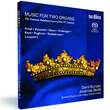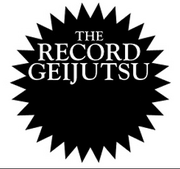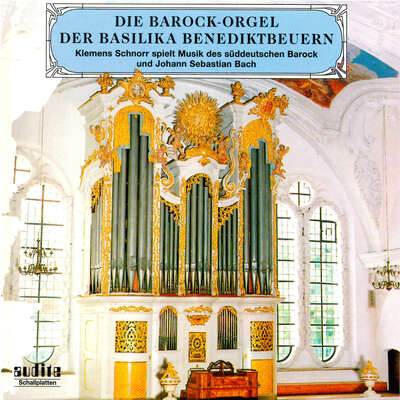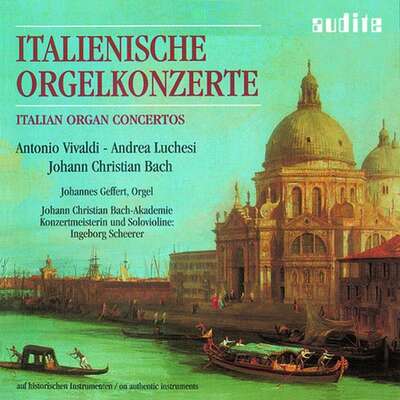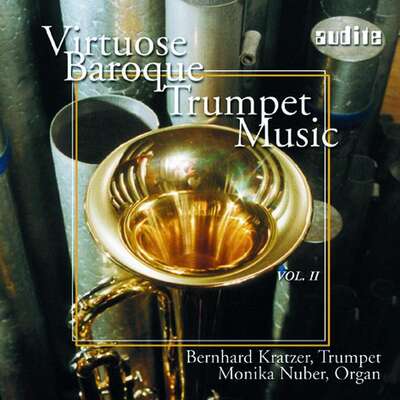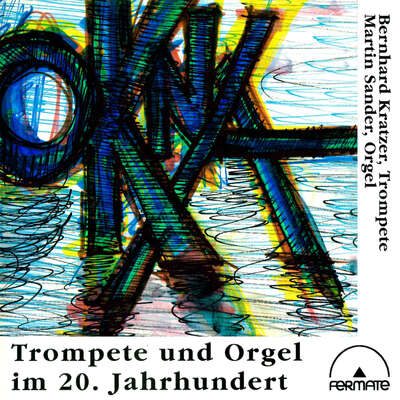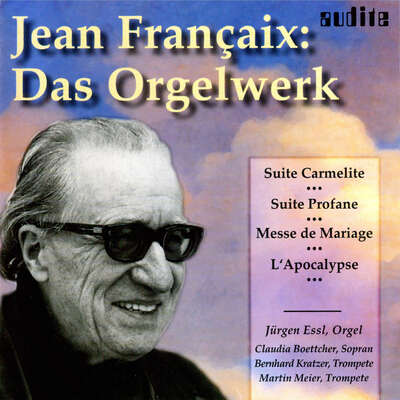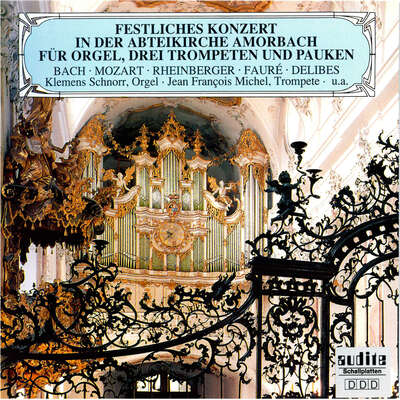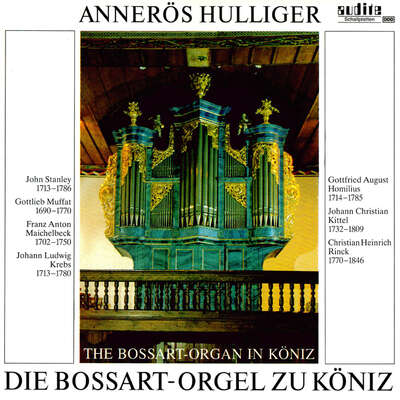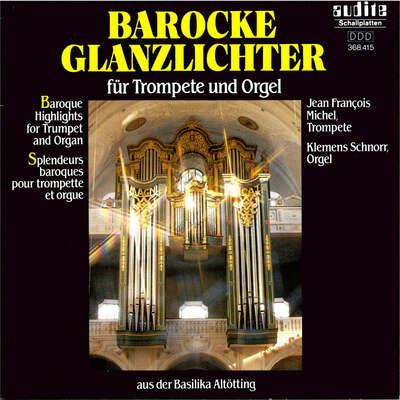
Die Rolle der Orgel am Wiener Habsburger Hof wird in dieser Aufnahme mit einer Auswahl von genuiner Tastenmusik und Arrangements abwechslungsreich beleuchtet. Aufgenommen im von den Vorfahren der Habsburger gegründeten Kloster Muri, wird im Zusammenspiel der beiden Bossart-Orgeln von 1743 und in der Verbindung von Orgel und Gregorianik ein bemerkenswertes musikalisches Zeitalter zum Leben erweckt.mehr
" [...] the performances are outstanding, with David Blunden and Johannes Strobl showing great musicality in the way they make the two organs blend." (The Classical Reviewer)
Titelliste
Diesen Bonustrack erhalten Sie ausschließlich als Download!
Details
|
Music for two Organs
The Viennese Habsburg Court of the 17th century |
|
| Artikelnummer: | 92.653 |
|---|---|
| EAN-Code: | 4022143926531 |
| Preisgruppe: | ACX |
| Veröffentlichungsdatum: | 26. Oktober 2012 |
| Spielzeit: | 84 min. |
Zusatzmaterial
Informationen
Die vorliegende SACD - aufgenommen im von den Vorfahren der Habsburger gegründeten Kloster Muri - widmet sich der Orgelmusik am Wiener Habsburger Hof des 17. Jahrhunderts. Schon Leopolds Vater und Großvater hatten in ihrer Hofhaltung der Musik einen wichtigen Stellenwert eingeräumt. Mit dem ausübenden Musiker Leopold I. (1640-1705) aber, der oft selber Proben und Aufführungen leitete, wurde die Wiener Hofkapelle zu einer der wichtigsten europäischen Musikinstitutionen der Zeit. Bedeutende Musiker wie Johann Jakob Froberger, Johann Kaspar Kerll oder Alessandro Poglietti fanden in Wien Anstellung als Hoforganisten. Eine Auswahl ihrer Kompositionen wird hier vorgestellt, ebenso weitere Werke des Barock- und Frühbarock von Priuli, Valentini, Ebner und Techelmann sowie von Kaiser Leopold I. selbst. Neben originalen Orgelwerken finden sich auf der Aufnahme auch Intavolierungen doppelchöriger Motetten und Canzonen. Mit diesen Bearbeitungen knüpfen die beiden Organisten Johannes Strobl und David Blunden an die Tradition ihrer historischen Vorgänger an und können die beiden prächtigen Bossart-Orgeln aus dem Jahr 1743 der Klosterkirche Muri sowohl als Soloinstrumente als auch als konzertierende Duo-Instrumente hervorragend präsentieren. Quellen aus dem Musikarchiv des Wiener Minoritenkonvents belegen für die Zeit um 1700, dass der Gregorianische Choral nicht a cappella, sondern mit Orgelbegleitung gesungen wurde. Diese heute kaum noch beachtete Praxis findet in der vorliegenden Aufnahme Berücksichtigung.
Besprechungen
www.alte-musik-forum.de | Donnerstag, 5. Februar 2015 | aficionado54 | 5. Februar 2015
Der Klang der beiden Orgeln von Joseph und Viktor Ferdinand Bossart in der Klosterkirche zu Muri ist wunderbar und von den Tontechnikern des Labels audite perfekt eingefangen worden, auch in Stereo ein Hochgenuss, obwohl hier Besitzer einer Mehrkanalanlage natürlich einen deutlichen Vorteil haben.Mehr lesen
www.musicweb-international.com | 04.12.2013 | Dan Morgan | 4. Dezember 2013 Recordings Of The Year 2013
Audite have figured in my Recordings of the Year before, and it was with great regret that I had to eliminate their aptly titled Polychoral SplendourMehr lesen
Ars Organi | Jg. 61, Heft 4 (Dezember 2013) | Martin Köhl | 1. Dezember 2013
Johannes Strobl und David Blunden bringen die Evangelien- und Epistelorgel der Klosterkirche Muri in idealer Weise zum Klingen, was sowohl bezüglich der gewählten Registerfarben wie bezüglich ihres durchsichtigen Spiels gesagt werden darf. [...] Diese CD hat im Übrigen aufgrund ihres originellen raum-zeitlichen Themas [...] einen hohen dokumentarischen Wert.Mehr lesen
www.musicweb-international.com | Wednesday 29th May 2013 | Dan Morgan | 29. Mai 2013
Audite have produced some of the finest organ recordings I know; among them is the first in their three-volume set of Franck played by Hans-EberhardMehr lesen
The ancient Abbey Church of Muri has a long association with the Habsburg dynasty, so it’s appropriate that some of the music here is by Leopold I (1640-1705), otherwise known as Leopold Ignatius Joseph Balthasar Felician. Of the two organists Sydney-born David Blunden is new to me, but Johannes Strobl, Muri’s Director of Music, impressed me greatly with that collection of Christmas Preludes. In the choral items – O quam dulcis a 8, Victimae paschali laudes, Veni Sancte Spiritus and the Salve Regina – they are joined by the Choralschola der Cappella Murensis.
The two organs – the ‘Evangelienorgel’ played by Blunden, the ‘Epistelorgel’ played by Strobl – were built in 1743 by Joseph and Viktor Ferdinand Brossart. Both have been repaired and restored over the years, most recently in 1991-1992. Situated on either side of the High Altar they set the stage for some delightful interplay and ear-pricking antiphonal effects. That’s immediately evident in the opening piece by the Venetian composer – and Kapellmeister at the Habsburg court – Giovanni Priuli.
What a joyful noise these baroque organs make; clearly they aren’t large, but their forthright character – not to mention their lovely top-end sparkle – are superbly caught by the Audite engineers. The recording has plenty of body as well, with a discreet but telling bass, and there’s no muddying echo either. Most impressive is the enthusiasm and polish of these performers, whose ebullience and sure sense of style give the music such a lift. This tasty fare is nicely contrasted with the much leaner but wonderfully buoyant Conzon a 6 by Giovanni Valentin, who succeeded Priuli as court Kapellmeister in 1626. The latter’s piping little Canzone Seconda is a joy to hear; sonorities are always pleasing, the music is perfectly proportioned and all decorations are tastefully executed.
The programme is cleverly constructed too; Priuli’s stately O Quam Dulcis a 8 and the dark-hued Easter Sequence are a good foil to what’s gone before. There’s an extra weight and warmth to the latter – not to mention refined playing, singing and sonics – that cossets the ear and gladdens the heart. Indeed, it’s ages since I’ve heard such disciplined and dulcet tones from Baroque organs, and I suspect the sense of space and ‘air’ around the choir is even more tinglesome in multichannel.
After the deliciously florid and very danceable rhythms of Wolfgang Ebner’s Partite sopra l’Aria Favorita Froberger’s slow Toccata and the fluting Capriccio are taken by Strobl and Blunden respectively; needless to say both pieces are impeccably done. They rejoin the small but beautifully blended choir for what is probably the most moving and atmospheric work here, the Pentecostal Sequence Veni sancte Spiritus. Back in the days of vinyl this is what we called a demonstration-quality recording; happily, that’s also true of the CD layer, which suggests Audite have mastered this disc with great skill and sensitivity.
The pieces by Leopold I – now grave, now animated – are accomplished enough, but it’s Valentini pupil Johann Kaspar Kerll’s cuckoo imitation – a conceit favoured by composers of the period – that’s sure to raise a smile. Not only is it artfully written it’s also played with evident delight and a wonderful lightness of touch; and there’s more mimicry and wit to be heard in the bright, fugal cacophony of grasshoppers in Clamor grillorum campestrium. After that spot of levity Blunden plays the majestic Ricercar by the Austrian Franz Mathias Techelmann, while Strobl and the choir round off this cherishable programme with Techelmann’s simple yet deeply affecting Salve Regina; indeed, the splendid acoustics of this venerable building, its characterful organs and the you-are-there recording combine to produce some of the most ravishing sounds imaginable.
Audite have done it again; their consistently high production values – a surprisingly rare commodity in recorded music these days – extend to the glossy, informative and well-presented booklet and super jewel case; alas, it seems the latter may become a rarity, as the first of Audite’s new Vierne discs with Hans-Eberhard Roß – awaiting review – comes in a ghastly Digipak. That said, I have no reservations about this Muri disc which, like that Franck set in 2008, could well be one of my picks of the year.
Radiant music, superbly played, sung and recorded; a must for Baroque buffs, organ fanciers and audiophiles alike.
F. F. dabei | Nr. 11/2013 (18.-31.05.2013) | 18. Mai 2013
Music for two organs
Der Wiener Habsburger Hof des 17.Jahrhunderts
Die vorliegende SACD widmet sich der Orgelmusik am Wiener Habsburger HofMehr lesen
Berliner Zeitung | N r. 108 (11./12. Mai 2013) | Peter Uehling | 11. Mai 2013 Unfrommes Grillenzirpen mit Wind
Die Musik der kaum bekannten Komponisten ist überbordend, und das nicht nur klanglich. David Blunden und Johannes Strobl, der Hausorganist, haben Vokalkonzerte und instrumentale Canzonen auf zwei Orgeln verteilt, und die Spielfreude scheint durch diese Teilung die doppelte geworden zu sein.Mehr lesen
Musica | N° 245 - Aprile 2013 | Michele Bosio | 1. April 2013
Ecco due dischi che i cultori delle musiche a due organi e quattro mani nonMehr lesen
Aargauer Zeitung | Samstag, 30. März 2013 | Christian Berzins | 30. März 2013 Von Wien nach Muri
Die Wurzeln einer Orgel-CD aus Muri gehen zurück aufs Jahr 1027, dannzumalMehr lesen
klassik.com
| 19.02.2013 | Marion Beyer | 19. Februar 2013 | Quelle: http://magazin.k...
Beeindruckende Repertoirevielfalt
Blunden, David & Strobl, Johannes spielen – Werke für zwei Orgeln von Priuli, Valentini u.a.
Die spannende und äußerst abwechslungsreiche Zusammenstellung von (Orgel-)Kompositionen des Habsburger Hofes bezeugt den musikalischen Reichtum am barocken österreichischen Hof. Aufgrund der sehr offenen und gleichzeitig überaus professionellen Herangehensweise bei der Erarbeitung der teils bislang unbekannten musikalischen Quellen verdient diese Einspielung ein großes Lob und eine deutliche Empfehlung.Mehr lesen
www.klavier.de
| 19.02.2013 | Marion Beyer | 19. Februar 2013
Beeindruckende Repertoirevielfalt
Blunden, David & Strobl, Johannes spielen: Werke für zwei Orgeln von Priuli, Valentini u.a.
Das zugegebenermaßen komplexe Konzept dieser Einspielung ist spürbar fein durchdacht und auf vorbildliche, professionelle Weise umgesetzt worden. [...] Die spannende und äußerst abwechslungsreiche Zusammenstellung von (Orgel-)Kompositionen des Habsburger Hofes bezeugt den musikalischen Reichtum am barocken österreichischen Hof. Aufgrund der sehr offenen und gleichzeitig überaus professionellen Herangehensweise bei der Erarbeitung der teils bislang unbekannten musikalischen Quellen verdient diese Einspielung ein großes Lob und eine deutliche Empfehlung.Mehr lesen
Audiophile Audition | January 14, 2013 | John Sunier | 14. Januar 2013
This recording was made on the two small organs built in 1743 (and sinceMehr lesen
www.SA-CD.net | December 18, 2012 | Geohominid | 18. Dezember 2012
Audite are doing a wonderful exercise of musical archaeology in theirMehr lesen
ouverture Das Klassik-Blog | Mittwoch, 5. Dezember 2012 | 5. Dezember 2012
Das Kloster Muri, gegründet 1027, war das Hauskloster der Habsburger. ImMehr lesen
Record Geijutsu | December 2012 | 1. Dezember 2012
japanische Rezension siehe PDFMehr lesen
Recklinghäuser Zeitung
| Freitag, 16. November 2012 (Nr. 268) | Jörg Maria Welke | 16. November 2012
Majestätisch
Musik für zwei Orgeln aus der Blütezeit des Habsburger Hofs in Wien
Die Geschichte des Klosters Muri ist von Anbeginn fest mit der des HausesMehr lesen
http://theclassicalreviewer.blogspot.de | Friday, 14 December 2012 Music for Two Organs: The Viennese Habsburg Court of the 17th Century – a new Audite release with outstanding performances from David Blunden and Johannes Strobl
[...] As I have already made clear, the performances are outstanding, with David Blunden and Johannes Strobl showing great musicality in the way they make the two organs blend, as well as in their individual organ solos. The excellent Choralschola der Cappella Murensis remind us of the use of Gregorian chant in the liturgy.<br /> <br /> With an excellent recording, excellent booklet notes by Johannes Strobl and full organ specifications and registrations, this new release receives an enthusiastic recommendation.Mehr lesen
With an excellent recording, excellent booklet notes by Johannes Strobl and full organ specifications and registrations, this new release receives an enthusiastic recommendation.
